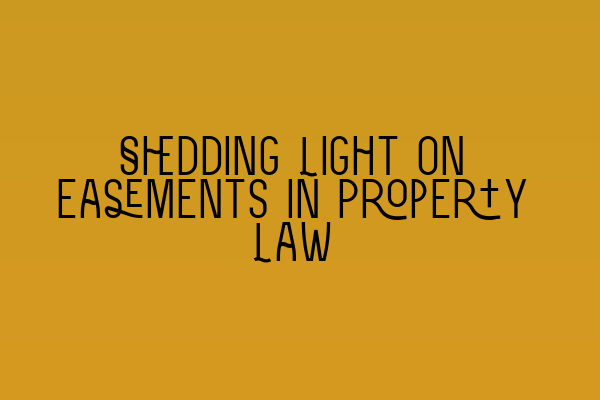Shedding Light on Easements in Property Law
As a property owner or even as someone looking to purchase property, it’s essential to understand the concept of easements in property law. Easements can have a significant impact on your rights as a property owner and can affect how you use and enjoy your property.
In this blog post, we will shed light on easements in property law, what they are, how they are created, and what rights and responsibilities they entail.
What is an Easement?
In simple terms, an easement is a right granted to a person or entity that allows them to use or access someone else’s property for a specific purpose. This means that even though you are the sole owner of a piece of land, certain individuals or organizations may have the right to use or access your property in some specific way.
Easements are often created to provide necessary access to utilities, such as water, electricity, or gas. For example, if your property is adjacent to a public road, the local utility company may have an easement that allows them to install and maintain utility lines below or above your property.
Types of Easements
There are various types of easements, each serving a specific purpose. Some common types of easements include:
1. Right of Way Easement: This type of easement allows individuals or entities to pass through your property to access another property or public space. For example, if your property is in the middle of two other properties, the owners of these neighboring properties may have a right of way easement across your land to reach their properties.
2. Utility Easement: Utility companies often need easements to install and maintain utility lines, such as power lines, gas pipes, or sewer lines. These easements ensure that the utility companies have the right to access your property for maintenance and repairs without seeking your permission every time.
3. Easement by Necessity: This type of easement arises when one property is landlocked, meaning it has no direct access to a public road or through other means. In such cases, the landlocked property may have an easement by necessity across another property to gain access.
4. Easement by Prescription: An easement by prescription is created when someone openly and continuously uses another person’s land for a specific period without the owner’s permission. After a certain number of years, the person using the land may acquire an easement by prescription, granting them the legal right to continue using the land.
Creating an Easement
There are several ways through which easements can be created:
1. Express Grant: An easement can be created through an express grant, which is a formal agreement between the property owner and the party seeking the easement. This agreement is typically documented in writing and signed by both parties.
2. Implied Easement: In some cases, an easement may be implied based on the actions and behavior of the parties involved. For example, if someone sells a piece of land that is inaccessible except through another property, an implied easement may be created to provide access to the landlocked property.
3. Easement by Prescription: As mentioned earlier, an easement by prescription can be created when someone openly and continuously uses another person’s land without permission for a specific period.
Protecting Your Rights
As a property owner, it’s crucial to protect your rights when it comes to easements. Before purchasing a property, it’s advisable to conduct a thorough title search to identify any existing easements. This will help you understand the rights and limitations associated with the property.
If you have concerns or disputes regarding an existing easement, it’s essential to seek legal counsel. A property law solicitor can review the relevant documents, assess the situation, and provide guidance on how to protect your rights or negotiate changes to the easement.
Understanding easements in property law is vital for property owners and potential buyers. By having a clear understanding of what easements are, how they are created, and how they can impact your property rights, you can navigate property transactions and disputes more effectively.
To learn more about property law and prepare for the upcoming SRA SQE exams, check out these related articles:
– SQE 1 Practice Exam Questions
– SQE 1 Practice Mocks FLK1 FLK2
– SQE 2 Preparation Courses
– SQE 1 Preparation Courses
– SRA SQE Exam Dates
In conclusion, easements play a crucial role in property law, allowing individuals and entities to access or use someone else’s property for specific purposes. By understanding the different types of easements, how they are created, and how to protect your rights as a property owner, you can better navigate property transactions and disputes. Stay informed, seek legal counsel when needed, and ensure you are well-prepared for the SRA SQE exams by exploring the resources mentioned above.
